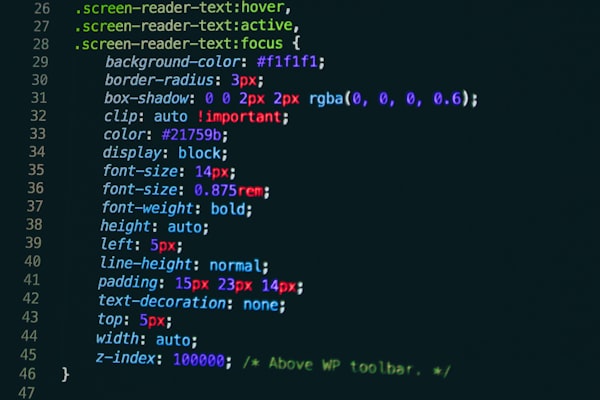1. Introduction to CSS Transitions and Animations
Welcome, curious coders and style-sheet savants, to the magical world of CSS Transitions and Animations! If you've ever wanted your website to have more pizzazz than a Broadway musical, you're in the right place.
Why Use CSS Transitions and Animations?
Why, you ask? Oh, dear reader, how about we transform that question into: why not use CSS transitions and animations? Let me enlighten you. Imagine your website as a party. Without transitions and animations, it's like a party with stale chips, flat soda, and that one guy who insists on playing the guitar but only knows 'Wonderwall.' Add transitions and animations, and suddenly, your party has a live DJ, a chocolate fountain, and a surprise appearance from Beyoncé. In other words, CSS transitions and animations take your user experience from 'meh' to 'memorable.'
CSS transitions and animations are the keys to making your website interactive and engaging. They can help you guide your user's attention, provide visual feedback, and even make mundane actions like loading a page feel more dynamic. They're like the seasonings in your web design kitchen – just a pinch can make a world of difference.
The Difference Between CSS Transitions and Animations
Now, let's talk differences. CSS transitions are the cool kids who are always smooth, always subtle. They allow you to animate a change from one property value to another, over a given duration. Think of them as the effortless glide from one dance move to another.
CSS animations, on the other hand, are the life of the party. They’re your sequence of dance moves, the choreography to your web page performance. With the @keyframes rule, you get more control over the intermediate steps in an animation sequence, not just the start and end.
To sum up: transitions are smooth, animations are dynamic. It's like the difference between an improv jazz band and a meticulously planned orchestral symphony - both have their place, depending on the mood you're trying to set.
So, buckle up, dear reader. We're about to dive head-first into the fascinating world of CSS transitions and animations. By the end of this guide, you’ll be able to spice up your websites like a Michelin-starred chef.
2. Understanding CSS Transitions
Alright, it's time to pull back the curtain on CSS transitions. But don’t worry, you won't need an Indiana Jones hat or a magnifying glass. Just a dash of curiosity and a sprinkle of patience!
Exploring the CSS Transition Property
CSS transitions are smoother than a jazz saxophone solo. They're like the chameleons of the web world, subtly changing from one state to another. How do they do it? With the transition property, of course!
The CSS transition property is like the secret recipe to your grandma's apple pie - it has a few essential ingredients. There's the property you want to transition (like opacity or width), the duration of the transition (in seconds or milliseconds), the timing function (like linear or ease-in), and the delay before the transition starts. Mix them all together and voila! You've got yourself a transition.
Practical Examples of CSS Transitions
Let's take a look at a real-life example. Suppose you have a button that you want to pop a little when you hover over it. A pinch of transition can make this as smooth as a ballroom waltz. Your CSS might look something like this:
.button {
transition: transform 0.3s ease-out;
}
.button:hover {
transform: scale(1.1);
}
And there you have it! A button that grows when hovered on, creating an engaging, dynamic user experience.
Common Pitfalls and How to Avoid Them
Now, let's talk pitfalls. Transitions can be tricky little creatures, and there are a few common mistakes that can trip you up. One is forgetting that not all properties can be transitioned. Sorry, folks, but you can't transition to a display: none like a Broadway star exiting the stage. Another pitfall is setting a transition duration so short, it's over faster than a blink. Remember, transitions are about smoothness and subtlety - give them the time they need to shine.
So, now that you've got the low-down on CSS transitions, you're ready to add that extra touch of dynamism to your websites. And always remember, with great power comes great responsibility - or in this case, with great transition comes great subtlety. Use it wisely!
3. Going Deeper: CSS Animations
Fasten your seat belts, ladies and gents, because we're about to take a deep dive into the exciting world of CSS animations. These are not your grandma's transitions! Animations are like the Hollywood blockbuster to transitions' indie film – bigger, bolder, and with more control over the narrative.
What Makes CSS Animations Unique?
CSS animations are unique because they're like the director of a movie. They call the shots, deciding exactly how and when certain elements on your webpage change over time. With animations, you can manipulate any number of properties in complex ways across multiple keyframes. They're not just a one-trick pony – they're the whole circus!
Breaking Down the @keyframes Rule
Now, let's break down the star of the show, the @keyframes rule. This is where you specify what your animation should do at each stage of the timeline. Think of it as choreographing a dance routine for your webpage elements.
You start by giving your animation a name (something descriptive like 'bounce' or 'rotate'), and then you define what happens at different points during the animation. These points (or keyframes) can be defined as percentages of the total animation duration, allowing for precise control over the sequence of events.
Real-World Examples of CSS Animations
Let's take a look at a practical example. Ever wanted to create a bouncing ball effect? With CSS animations and the @keyframes rule, it's as easy as pie! Here's a simple example:
@keyframes bounce {
0%, 100% { transform: translateY(0); }
50% { transform: translateY(-20px); }
}
.ball {
animation: bounce 2s infinite;
}
In this snippet, we've created a 'bounce' animation that moves a ball element up and down in a continuous loop. Isn't that just the bee's knees?
Remember, CSS animations are your playground. With them, your imagination is the only limit. So go ahead, explore, experiment, and animate like there's no tomorrow!
4. CSS Transitions vs. CSS Animations: Which to Use When?
And now, ladies and gentlemen, it's time for the grand showdown - CSS transitions vs. animations. It's like choosing between pizza and ice cream. Both are delicious, but they satisfy different cravings. So, let's find out which one is right for you.
Comparing Performance: Transitions vs. Animations
If this was a race, CSS transitions would be the sprinters, while animations would be the marathon runners. Transitions are perfect for simple, quick changes from one state to another. They're lightweight and don't need much setup. Animations, on the other hand, are built for more complex, multi-stage transformations that occur over a longer time.
In terms of performance, both are pretty efficient, but transitions have a slight edge because they're simpler and require less computing power. However, animations can be optimized with properties like will-change to hint browsers about what to expect, so they can prepare and perform more efficiently.
Making the Right Choice for Your Project
Choosing between transitions and animations is like picking the right tool from your toolbox. You wouldn't use a hammer to screw in a bolt, right?
Use transitions when you want to animate a change in response to user interaction, like a hover effect or a change in color on a button click. Transitions are all about simplicity and subtlety.
On the other hand, use animations when you want something more complex, like a loading spinner, a bouncing ball, or an element that needs to move along a specific path. Animations give you the control to choreograph more intricate sequences.
Remember, both transitions and animations can bring your webpage to life. The key is to know when to use which, like knowing when to add a dash of salt or a sprinkle of sugar to your recipe. So, wield these tools wisely, and create something spectacular!
5. Advanced CSS Animation Techniques
Alright, web wizards, it's time to roll up our sleeves and dive into the deep end of the CSS animation pool. Are you ready to unleash the full power of your CSS sorcery? Let's go!
Creating Complex Animations with CSS
Animating with CSS is like conducting a symphony. At first, you might just manage a simple melody, but with practice, you can create an entire orchestral masterpiece! Complex animations may involve multiple elements, chained animations, staggered starts, and synchronized timing - think of it as a ballet performance, where each element has its role to play in the grand spectacle.
One way to create complex animations is by combining multiple @keyframes rules. This allows you to choreograph a series of movements that give the illusion of continuous motion. You can also experiment with transformation functions like rotate(), translate(), scale(), and skew(), and properties like animation-direction and animation-fill-mode for extra flair.
Using Animation Libraries and Tools
However, when the going gets tough, the tough get... libraries! CSS animation libraries like Animate.css, Popmotion, and GSAP can provide ready-made animations that you can plug into your projects. It's like having a pre-cooked meal; just heat it up and serve!
There are also tools like Keyframes.app and Haiku Animator that allow you to create animations visually, without writing a single line of CSS. It's like painting with a digital brush - you get to see the results in real-time!
Remember, advanced CSS animation techniques are all about creativity and experimentation. So, don't be afraid to play around, make mistakes, and learn from them. After all, as Picasso probably didn't say, "Every great web designer was first an explorer." So, go forth and animate!
6. Optimizing Your CSS Animations for Better Performance
Welcome to the land of smooth, buttery animations. Here, we care about performance as much as a race car driver cares about speed. Let's get your CSS animations running faster than a cheetah on a caffeine buzz!
Best Practices for Animating with CSS
Animating with CSS is like running a marathon. You need to pace yourself and optimise your energy usage. Stick to animating properties that are cheap for browsers to animate for better performance. These are typically opacity and transform. They're like the economy class of CSS properties - good performance at a low cost.
Avoid layout thrashing, which happens when you read and write to the DOM in quick succession, causing the browser to do extra work recalculating styles and layout. It's like trying to paint a room while someone else is still moving the furniture around.
Also, keep your animations simple. Remember, not every element needs to dance around like it's carnival season. Sometimes, less is more.
Improving Animation Performance with Hardware Acceleration
Now, let's talk about hardware acceleration. It's like upgrading from a bicycle to a motorcycle for your animations. By promoting an element to its own composite layer, the browser can offload some of the rendering work to the GPU, which is more efficient at handling graphical tasks.
You can do this by applying a 3D transform to an element, like transform: translateZ(0);. It's like telling the browser, "Hey, this element is important. Let's move it to the fast lane."
Remember, optimising your CSS animations is all about creating a balance between visual flair and performance. You want your website to be a sleek, fast sports car, not a clunky, slow-moving van. So, optimise wisely, and let the smoothness begin!
7. Integrating CSS Transitions and Animations with JavaScript
Welcome, code whisperers, to the grand alliance of CSS and JavaScript! When these two join forces, they can create an interactive experience as mesmerising as a fireworks display on a starry night. Let's see how this dynamic duo can enhance your animations and transitions!
How JavaScript Can Enhance Your CSS Animations
Think of JavaScript as the puppet master and CSS as the puppet. JavaScript can dynamically change the styles and animation parameters based on user interactions or other triggers. It's like the difference between watching a pre-recorded show and a live performance - there's a level of interactivity that makes the experience more engaging.
With JavaScript, you can start, pause, or reverse an animation, control the speed, or even chain multiple animations together. It can also help you calculate values for complex animations, like bouncing or elastic movements. It's like having a personal assistant who's ready to jump in whenever things get too complicated.
Case Studies of JavaScript and CSS Animations Working Together
Let's talk about real-life examples. Ever seen those menus that slide out when you click a button? That's JavaScript and CSS shaking hands. The animation is handled by CSS for performance, but the triggering of the animation is controlled by JavaScript based on user interaction.
Or consider a photo carousel that automatically moves to the next photo but stops when you hover over it. That's JavaScript pausing a CSS animation in response to a hover event.
When you combine CSS and JavaScript, you get the best of both worlds - the performance of CSS and the flexibility of JavaScript. It's like a superhero team-up, where each hero brings their unique abilities to create a fantastic user experience. So, don't be shy about mixing these two powerful tools. After all, teamwork makes the dream work!
8. Future of CSS Transitions and Animations
Get ready, web wranglers, because the future of CSS transitions and animations is as bright as a supernova! With new features on the horizon and ongoing developments in the field, it's an exciting time to be a web designer.
Upcoming CSS Animation Features to Look Forward to
As of now, CSS is like a talented painter with a limited palette. But the future promises a veritable rainbow of new features. For instance, there's talk about a parent timing function which will allow an animation to inherit the timing of its parent. It's like a baby duck following its mother in a perfectly synchronised waddle.
We might also see a more advanced animation syntax that allows for more complex animations without needing to lean on JavaScript. Imagine choreographing a ballet performance where the dancers can perform intricate moves in perfect harmony, all controlled by CSS!
How to Stay Updated with CSS Animation Trends
Staying updated in the world of CSS animations is like being a surfer - you have to keep an eye on the wave to ride it successfully. Here are a few ways to do that:
- Follow the W3C CSS Working Group, the folks who decide what goes into CSS. They're like the weather forecasters for the CSS world.
- Read articles and tutorials from trusted web design blogs and resources. There's a wealth of knowledge out there, just waiting to be discovered.
- Participate in web design and development communities. They're like your fellow surfers, always ready to share tips and tricks.
9. Conclusion: Mastering CSS Transitions and Animations
Well, folks, we've come to the end of our rollercoaster ride through the wild and wonderful world of CSS transitions and animations. It's been a journey filled with colourful examples, playful metaphors, and more than a few cheesy jokes. But before we disembark, let's take a moment to reminisce about our adventure.
Recap of Key Learning Points
We started with the basics, learning about the magic of CSS transitions and animations and their ability to bring a webpage to life. We then dove deeper, exploring the inner workings of these tools, like a team of web design archaeologists discovering ancient CSS secrets.
We compared transitions and animations, debated their merits, and learned how to pick the right tool for the job. We even ventured into the advanced realm, creating complex animations and optimising them for performance.
Then, we united CSS with JavaScript, creating a superhero team capable of delivering engaging and interactive web experiences. And finally, we gazed into the future, dreaming of the exciting possibilities that lie ahead.
Resources for Further Learning
But our journey doesn't have to end here. The web is full of resources to help you continue your learning. Websites like MDN Web Docs and CSS-Tricks are like treasure troves of information. Books like "CSS Secrets" by Lea Verou are like personal guides to the land of CSS.
And remember, the best way to learn is by doing. So, go ahead, open your code editor, and start playing around with CSS transitions and animations. Create, experiment, fail, learn, and repeat. After all, as the old saying goes, "Practice makes perfect... animations!"








